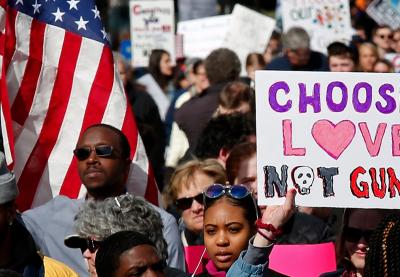Lesson Plans Can Wait
There is never enough time to complete all the curriculum and finish all the activities with your students. But today is a day to embrace the messiness, embrace that slightly derailed scope and sequence to give weight to topics that are happening now. When we ignore or dismiss an important event, we show our students that it is not worthy of our time. Say something, and show your students the power of voice—yours and their own.
They're Not Too Young
Research shows us that children can handle difficult topics at a very young age. In fact, speaking with them about difficult topics when they're young better prepares students to positively process and heal later in their lives. The images from this weekend spotlight the incredible power that even very young people possess, from 9-year-old Yolanda Renee King calling back to her grandfather's famous dream to 11-year-old Naomi Wadler speaking on behalf of forgotten victims of gun violence. View and discuss clips from the march, and watch as your students become empowered by their peers.
Have Their Backs, but Let Them Lead
This movement is led by youth. They are organized, inclusive and very powerful. More than 200,000 people took part in the #MarchforOurLives march in Washington, D.C., and an estimated 800 other marches took place across the country. Your students will tell you what they want to talk about and need to process. Let them ask the questions, let them guide the discussions and let them lead. Give them opportunities to do something about the topics they feel passionate about. Too often we assume kids need us to show them the way and hold their hands to get them there. This weekend's march is evidence that, when we allow them to lead, they can do incredible things.
Expect Emotion
There were many raw and impassioned moments this weekend, as well as over the course of this movement. The topic of gun violence in the United States is sensitive and extremely polarizing. We are all witnesses to tragedy after tragedy, and as much as we are affected, our students are too. Students who have seen or been involved in gun violence may show their emotions even more as this topic is brought to the national stage. Students whose families own guns or who don't support gun control legislation may be feeling defensive or even outraged. Be cognizant of who your students are and have a plan for when strong emotions come up. And don't be afraid to share your emotions with your students. Have you been personally affected by gun violence? What emotions do you have about this movement? Be appropriately transparent with your students. It will open doors and create meaningful connections.
Connect to History
Youth activism has a long history in this country and all over the world. Show your students that kids taking a stand is not a new phenomenon: Children facing water hoses in Birmingham, Dream Defenders in Florida, Anti-Apartheid activists in South Africa. All these movements had impact because of the direct action of youth. Show your class that this weekend's march was the next step in a long journey toward a safe and equitable society for all.
Not sure where to start your classroom conversation?
Try these discussion questions.
- Did you attend a march this weekend? What was it like? Can you share your experience?
- What have you heard about this movement or about the student leaders? From whom? Do you think young people and adults are talking about the movement in the same way? Why or why not?
- Do you think adults listen to people your age about important issues? Why or why not? Do you think that the rallies this weekend will make them more likely to listen? Why or why not?
- Why is it important for young people to lead this conversation/movement?
- Young people leading this movement are stressing the importance of voting and being educated in the issues facing our democracy. Why do you think they are emphasizing voting as an important way to make change?
- Can you think of other times in history when people came together to protest and make change? What does this movement have in common with past movements? How is it different?
Mascareñaz is the director of Equity Affairs for Wake County Public Schools and a former teaching and learning specialist for Teaching Tolerance.
